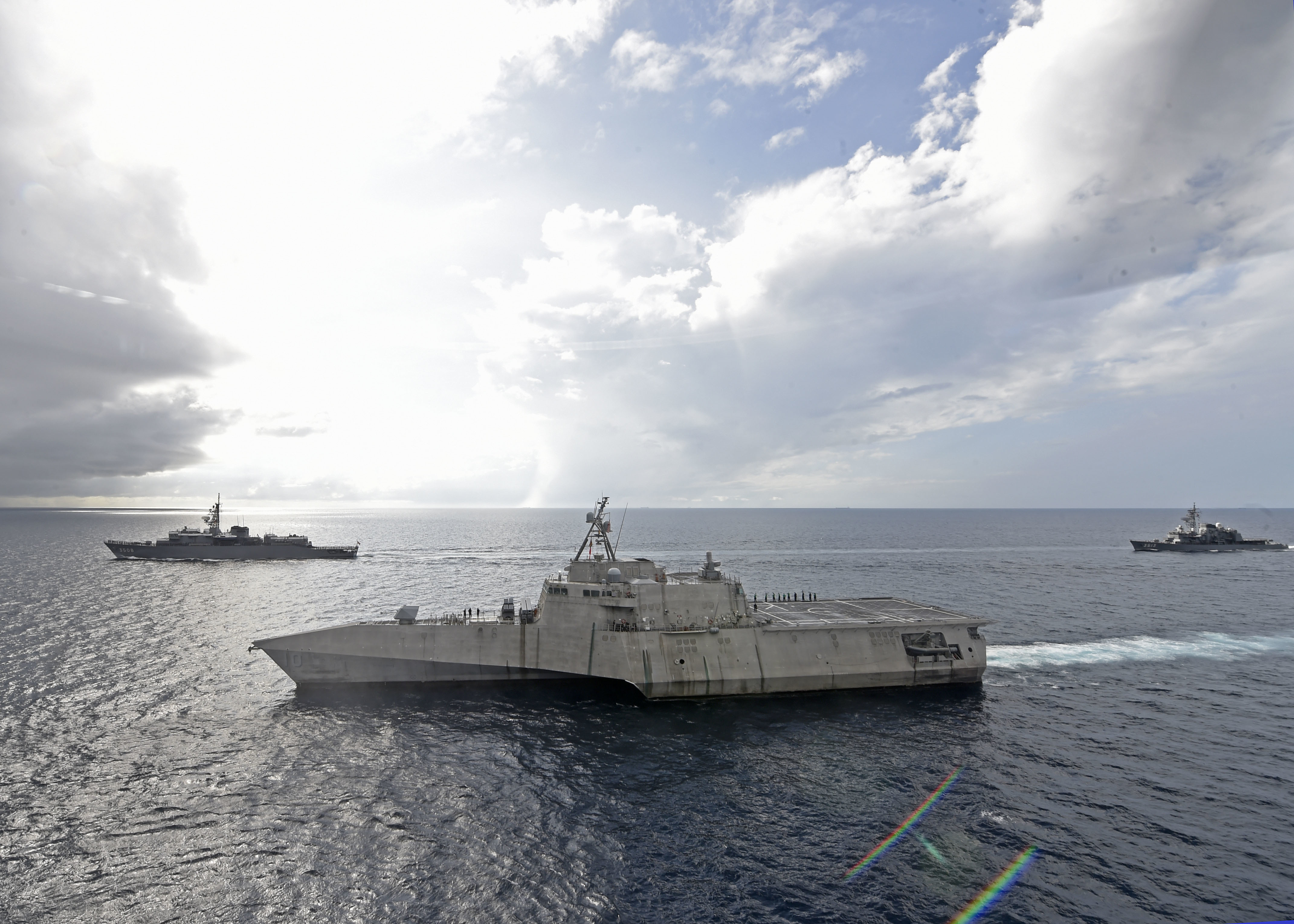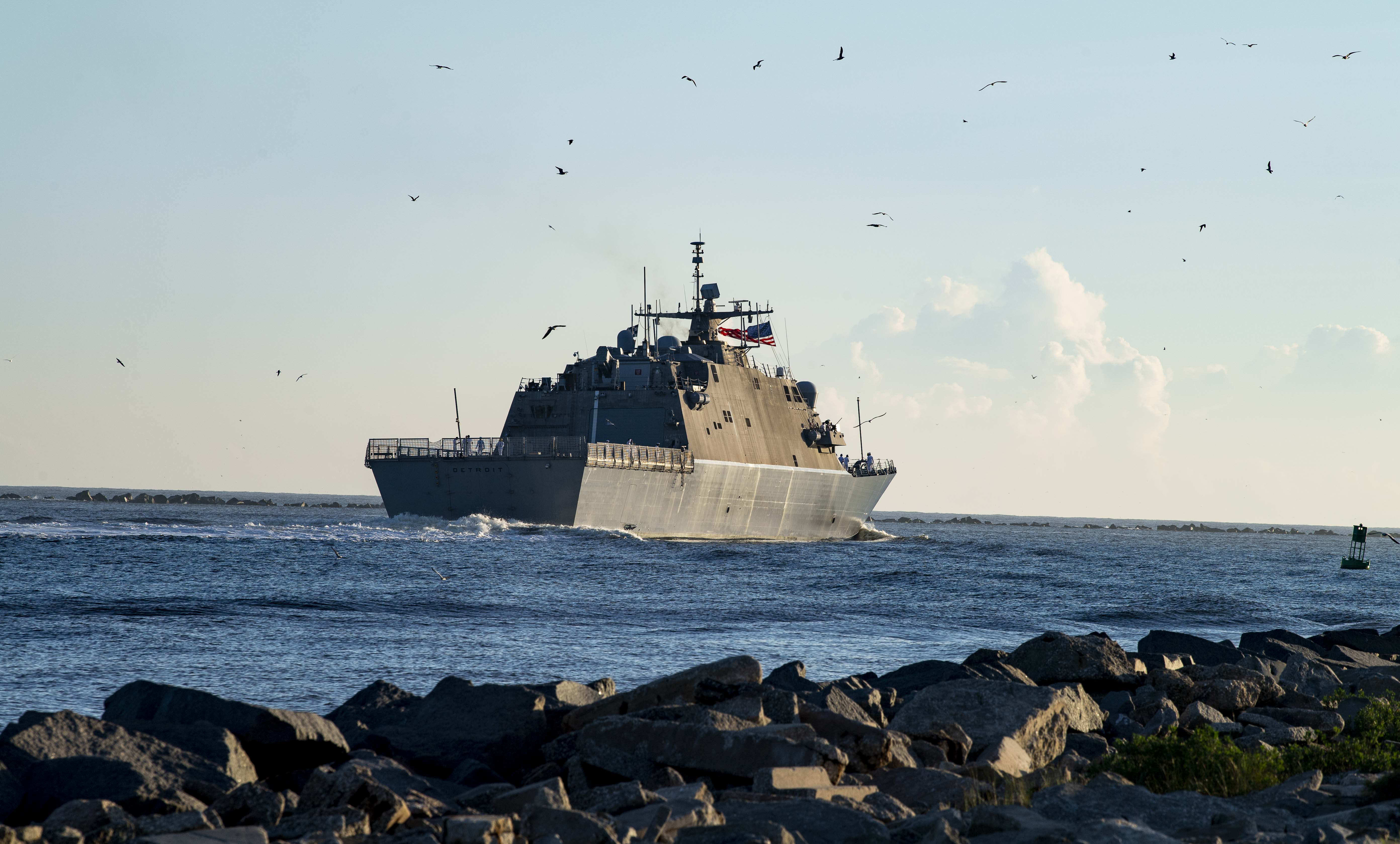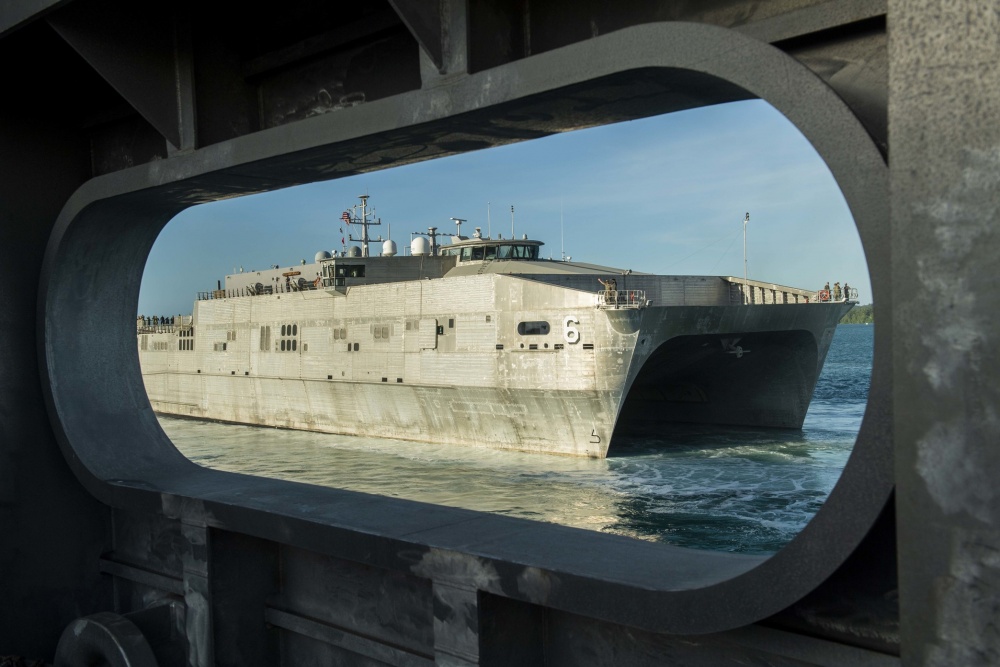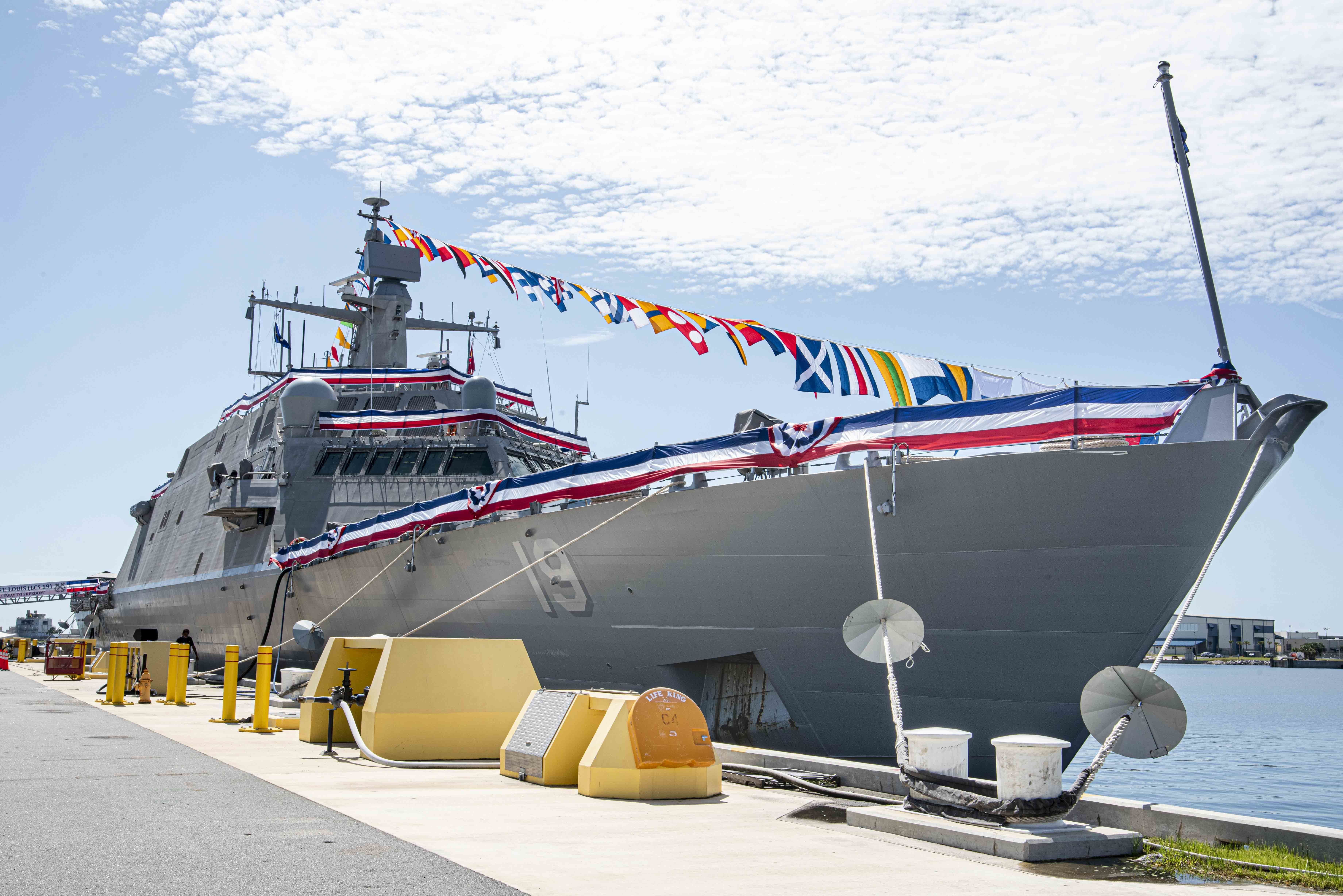
Navy officials in Washington and on the waterfront are trying to help the Littoral Combat Ships grow more reliable and maintainable, amid a surface navy-wide effort to focus on crew-level maintenance as a means of improving operational availability.
The LCS program has had eight major deployments since its first overseas deployment in 2013. Commander of Naval Surface Forces Vice Adm. Roy Kitchener said among the biggest lessons learned from those has been the need to make crews more self-sufficient and able to keep their ship available for fleet commanders’ tasking.
He highlighted an LCS Strike Team being led by Program Executive Officer for Unmanned and Small Combatants Rear Adm. Casey Moton, which aims to address class design issues, increase the availability of spare parts – especially proprietary parts and diagnostic tools that maintenance contractors have access to but fleet sailors don’t – and increase accountability for ships’ post-shakedown availabilities.
“These efforts drive toward increased ship reliability and more operational days across the entire class,” Kitchener said last week during the annual Surface Navy Associations symposium.
In a separate panel at the conference, Moton addressed the strike team, saying “the bottom line is that the availability of the ships to the fleet commanders has not been what it needs to be, and we’ve had reliability issues in areas such as propulsion, cranes, radars and some other areas. We set up a strike team that’s a cross-functional mix of our shipbuilders and sustainers, and they are working very hard with a sense of urgency, going after specific problems.”
Moton went on to call it “an effort that first looks at reliability and making sure that we have all the feedback from our recent deployments in terms of what systems need to go be worked, and we’re hard at work with that,” he continued.
“And then also on the maintainability side, we’re working very hard to reduce the amount of time, once a system does go down, how long it’s going to take to get that system up. And there’s two pieces there: one is, we’re working with industry on how to more quickly get the original equipment manufacturer out there when we need to do the repairs, but the other aspect to be honest is to improve the Navy’s self-sufficiency. And Adm. Kitchener talked a fair amount about this earlier; I am fully onboard supporting and trying to make that happen. So getting our crews, getting our [Regional Maintenance Centers], getting our [In-Service Engineering Agents] better able to troubleshoot to support those ships, to prevent failures from happening. And this strike team is really focused on that, and it’s a key effort for me, one that we are working very closely with industry and are going to continue to do that.”

Moton mentioned that a specific effort on the reliability side was the Freedom-variant combining gears, for which the Navy and industry were conducting a root cause analysis. USNI News has since reported that the Navy declared the combining gears to be a class-wide defect for which builder Lockheed Martin would be responsible for fixing in new ships in the production line and existing ships already delivered to the Navy.
Moton said the strike team had already resolved many issues and “actually had a significant number of fixes that we were able to roll in to the shipbuilding line during new construction, so that’s been very fruitful.”
Asked by USNI News during a question and answer session whether the strike team would continue its work indefinitely or would reach a point of conclusion, Moton said the organization would continue on, but that didn’t mean it was dragging its feet on implementing changes.
“I think for a while, as we do these initial deployments and we continue to support the ships, there will be lessons learned, there will be issues that pop up, which we will have to go after. So I don’t see it necessarily ending, but I also don’t see it dragging out,” he said.
“We have to move with a sense of urgency, and we are getting after … reliability and the failure modes that have caused us the most problem.”
Additionally, Moton said, the strike team was also working with PEO USC, Naval Sea Systems Command, Naval Supply Systems Command, Kitchener as the type commander, and original equipment manufacturers in industry “to be able to respond more quickly and to be able to get more self-sufficiency into the crews.”
While Moton addressed self-sufficiency at the waterfront – Navy personnel being able to troubleshoot and fix the ships with less reliance on industry – Kitchener in his remarks addressed self-sufficiency during deployments, noting that empowering the Navy Maintenance Execution Teams (METs) instead of relying on shore-based maintenance teams from shipbuilders Lockheed Martin and Austal USA would be important as the LCS started deploying in greater numbers and spreading beyond today’s hubs in Singapore and in Guantanamo Bay, Cuba.
Though the Navy has experimented with expeditionary maintenance teams that could work out of non-hub locations such as Japan, the service is now also eyeing using its Expeditionary Fast Transports as something of an LCS tender for at-sea maintenance. Rather than send the LCS METs ashore, they could deploy aboard the EPF and stay near the LCS in case at-sea repairs beyond the capability of the crew were needed.

“In this case, [USS Gabrielle Giffords (LCS-10)]’s MET is forward-deployed aboard the USNS Burlington (T-EPF-10), keeping that maintenance capability in theater with the ship,” Kitchener said in his remarks. Giffords and Burlington are operating in U.S. Southern Command waters, conducting missions with partners and recently taking on Marines from Special Purpose Marine Air-Ground Task Force Southern Command (SP-MAGTF-SC) aboard Burlington.
Cmdr. Nicole Schwegman, a spokeswoman with Naval Surface Force Pacific, told USNI News that “The concept of utilizing expeditionary fast transport (EPF) vessels as maintenance support platforms for littoral combat ships (LCS) is not entirely new—it has been demonstrated previously on a small scale—but this is the first time that we have leveraged EPF to host LCS maintenance personnel capable of providing this level of robust sustainment support. We are continually looking for new and different ways to sustain LCS when operating forward to provide the Fleet Commanders with increased operational flexibility. Embarking Sailors on an EPF affords us an opportunity to build on previous LCS maintenance efforts and refine the LCS expeditionary maintenance concept. We are committed to developing multiple maintenance avenues for sustaining forward deployed LCS.”
Separate from the strike team, Kitchener is wrapping up his own LCS study, a follow-on to the major 2016 LCS study that revamped the entire ship program. The current study isn’t expected to have such dramatic results, but Kitchener said he’s focused on making sure the LCS ships are given the right mission sets, made as lethal and capable as possible, have a maintenance organization that can create higher operational availability, and have the best manning and training model.
Without revealing any results of the LCS study, Kitchener said last week that planned maintenance availabilities were being revisited, questioning whether monthly PMAVs were the right periodicity.
“My sense after looking at this program from both my last job, this job, is no, I don’t think it is. So we’re working with the team on that,” he said.
Kitchener said he was focused on improving waterfront maintenance for all surface ships, including deep looks at spare parts availability and other factors that could help maintainers get work done faster and get ships back to operating.

“We still struggle to acquire the parts our sailors need. Supply chain gaps, outdated business roles, funding shortfalls, and inaccurate prediction models continue to impede our ability to effectively maintain the waterfront,” he said.
“We’re actively contributing to a larger Naval Sustainment effort, leveraging an analytical approach to improve our supply chain’s performance globally. Within this effort, I am leading a specialized Demand Management Team aimed at improving the surface force’s sparing readiness and lowering cost by using improved material predictions to reduce unplanned maintenance. We have also partnered with the NAVSUP and NAVSEA teams on a Maritime Spares Campaign to revise our policies and improve our ordering process. If we can improve our sparing, we can increase system service life, reduce the repair burden in maintenance availabilities and generate more ships ready for tasking.”
Kitchener said a West Coast pilot program recently kicked off that could expand to the rest of the fleet if successful. Along with the fleet commander, he said he’s looking at spare parts issues that most affect the readiness of ships’ ballistic missile defense systems specifically.
“What are the ones that actually reduce the [casualty repair] time? And so we invested some money in that,” Kitchener said.
“We just got the ship parts out on the ship now, and we’re going to monitor that and see how we’re doing. I think the skillsets are there. I would tell you, if you go down there, sailors are doing their maintenance.”





